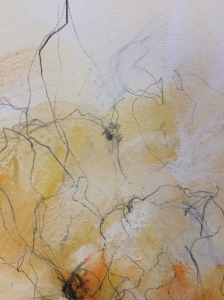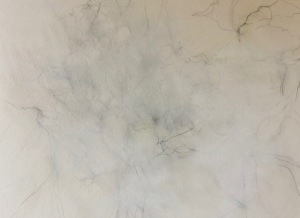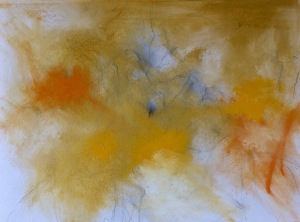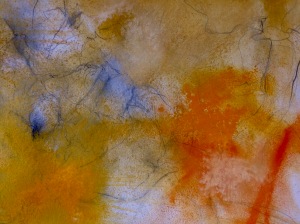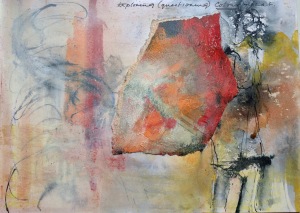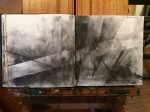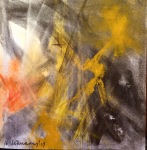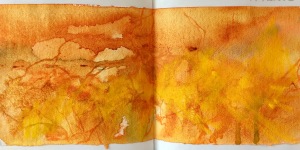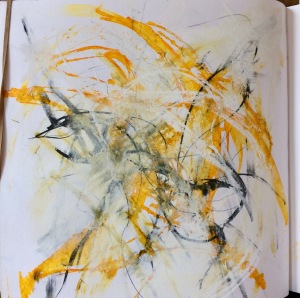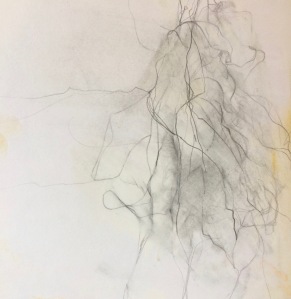As I’ve now progressed on to Level 3 in the Painting Degree, my work can be accessed at http://www.patricia422951level3.wordpress.com. Hope to see you there!
TUTOR REPORT – part 6
TUTOR REPORT
PART 6 and CRITICAL ESSAY
Overall Comments
You have delved into an abstraction of the concept of abstraction in your PP to make work, which is enticing through qualities of line and notions of drawing outside of a drawing. There are complex issues of drawing as a language which has been explored intensely. Your work could be infinite as your research into abstraction suggests. The work also suggests an ephemeral quality, which has echoes your journey into and through this unit.
Overall comments for the critical essay are below.
Feedback on assignment
Demonstration of technical and Visual Skills, Quality of Outcome, Demonstration of Creativity
Parallel Project-
First study- I am glad you found the distinction of abstraction and abstracting work useful at this stage and this has led to a new line of enquiry in your work. This first piece is almost a question visualised because there are no definite forms or borders. It would have been dangerous to do this because your work contains more movement and fluidity than the typical abstract art you have been referring to. The fading and loss of definite lines reinforce your notions of abstract thinking. It is almost a cartographic design of your thinking.
Second and third pieces- these pieces are a line of thought because that thought has become more solid with a definite bold line. Still explorative in questioning and application. I have written this before I read your explanation and hope it confirms your thinking as it echoes your intentions. The bold lines are not as harmonious or as fluid as the previous piece but perhaps this is due to a sporadic thought trial?
Final piece- This does feel like a conclusive piece in your journey as it is solid but incorporates your successful elements of mix media, the ephemera and the found and lost. As you say, there has to be an end point…for now. You have concluded the work with strong geometric lines in contrast to the freer lines of thought and this gives a dichotomy and tension between the abstraction and the once representational.
Experience, thought and idea– it seems like his parallel project are chapters of your journey in this unit from gathering your experiences, which then becomes thought about as you abstract ideas from these experiences which finally become the idea- something more concrete to represent this experience.
Sketchbooks
Demonstration of technical and Visual Skills, Demonstration of Creativity
The Abstraction Sketchbook is an explorative route, which was needed for you to investigate the wider concepts of line (memory, place and time). But also think about the contextual issues within contemporary art, such as, the ‘post-truth landscape.’ You shifted away from seeing too much in your work, such as figures and representations and remained objective in your discoveries. It seems like you allowed yourself to be the continuous and sometimes, unpredictable lines in your PP. A personal voive has been developed clearly.
Research
Context, reflective thinking, critical thinking, analysis
Your research surrounding your work has aided you in finding a voice through your practical work. You have meaningful artists and sources for your critical essay but they could be succinct more by linking them to each other. Your use of quotes supports your ideas and you have referenced accordingly. Also you have a solid bibliography. Critical analysis is mentioned in the next section but a personal voice is coming though in a complex idea. Sometimes this complexity could be simplified for the reader.
Learning Logs or Blogs/Critical essays
Context, reflective thinking, critical thinking, analysis
Critical essay-START
“REPRESENTATION OR ABSTRACTION: IS THAT THE POINT?”
“The eyes of one kind of painter look outward. The eyes of another look inward to the recollections that dwell in the recesses of the mind.” (Winifred Nicholson, 1987, page 239)
This comment by Winifred Nicholson in an article, ’Three Kinds of Artists”, first published by LYC Gallery in 1974, reflect a period in her artistic life when great change was happening, as artists, working in the first half of the 20th century, sought to reinvent the building blocks of artistic expression. There was an overturning of fundamental concepts and ideals in the movement from figurative to non-figurative art among her contemporaries and close associates, amongst whom was her husband at the time, Ben Nicholson, and Henry Moore, Ivon Hitchens, John Piper, Barbara Hepworth and David Jones. For most of the 1930s she lived in Paris where she became closely associated with Mondrian, Giacometti, Kandinsky, Gabo, Brancusi and Arp. This must have been an incredibly dynamic environment to experience. “These were years of inspiration – fizzing like a soda water bottle …Almost everyone one met as expressing genius, inventiveness, dedication to their vision…” is a description written by Nicholson for an exhibition of her abstract paintings at the Kalman Gallery in 1975. In ‘Three Kinds of Artists’ she talks about her personal journey to come to terms with the ‘primal forces’ that build art – ‘the primal force in geometry; in the circle, the rectangle, the triangle and their juxtaposition to one another… In colour: primal red, primal blue, primal yellow – no green, no neutrals…’ (Winifred Nicholson, 1987, page 239) This search led her to experiment freely, moving easily between representational and non-representational styles in the pursuit of her own dedicated vision.
I have begun this essay with a description of Nicholson’s experience because I feel to be at a similar point in my own practice. I constantly find myself drawn to abstraction and yet have no idea why and consequently have stayed in the safety of what can be seen with the eye. For me and for the purposes of this essay I see ‘abstraction’ as a process, a means of interpreting the world in order to find meaning. The Drawing 2 course with its concentration on in-depth investigation and experimentation into drawing has demanded new thinking. It has opened up alternate ways of ‘looking’ and consequently, a rethink about how to experience the world around me. As soon as ‘seeing’ becomes more akin to ‘awareness’, then a world of different responses become accessible. The senses of feeling, touching, remembering, responding, listening, exploring, expand vision and leave behind the limitation of the visual.
The question then arises, “how is this new way of ‘seeing’ to be expressed?” Can representational images reveal this new reality? Is abstracting what we experience the way to open up the world beyond what we see? Is it one or the other?
In my exploration into these questions, I decided to research two artists who on the surface appear opposite in their work and yet each have a profound effect on me as the viewer. I first encountered Diana Armfield at the 2016 Summer Exhibition at the Royal Academy, London. Among the huge array of paintings, I found that just one small canvas stood out. It was a simple image of nasturtiums in a vase. It was fascinating subsequently to read comments by Ken Howard in the forward to “The Art of Diana Armfield” by Julian Halsby, “…when we enter a mixed exhibition we immediately recognise the work of Diana Armfield. Here is a small, still voice that speaks to us quietly and persuasively. We have all witnessed each year how her work sings out at the Royal Academy of Arts Summer Exhibition, without the need of vast scale or strident colour…” (Julian Halsby,1995,page 7)
I love nasturtiums but this painting, entitled, ‘Nasturtiums with the Last Phlox’ was much more than a ‘flower painting’ and its impact went far beyond a favourite flower. There was a quiet dignity and grace in the image which gained dominance over the ‘noise’ of the exhibition. Layers and layers of feeling, love , recollections and continuity seemed to be evident in the simple image. The extension of the jug overhanging the shelf brought the image into the viewer’s space and it was as if we are pulled into the experience. The tension which was created by this eliminated the sense of finality or ending, emphasising to me, a feeling of continual renewal and energy.
It was with some surprise however that I read Armfield’s comment about her work in the article, ‘Diana Armfield RA’ , ( interview in Artists and Illustrators – page 24 – April 2017) “I think all my paintings are abstractions. The dull thing about abstract painting is that, to me, it has very limited meaning. It is akin to pattern making, just creating an ambience.”
This thought-provoking comment raised the issue of what ‘abstract’ art is? Going back to Nicholson’s comments at the beginning of this paper, it seemed to me that Armfield was an artist who both looked ‘outward’ at the same time as looking ‘inward to the recollections that dwell in the recesses of the mind.”
So what is abstraction?
The Tate defines the movement as, ” Abstract art is art that does not attempt to represent an accurate description of a visual reality but instead use shapes, colours, forms and gestural marks to achieve its effect. It may be based on a subject or may have no source in the external world.” (Tate website – art terms) Its development from the early twentieth century began first with the Expressionist movement in Russia involving “a free use of a Fauve-derived boldness of line and abstract use of colour as expressive entities in their own right “, (Camilla Gray, 2012, page 97) as can be seen in the work of artists such as Mikhail Larionov and Goncharova. Kandinsky (1866 – 1944) saw his abstract paintings as a pathway to spirituality. “He never lost the perception from early childhood that all objects and beings have an inner reality as well as an external form.” (Charlene Spretnak, 2014, page 82) But how to replace the ‘object in painting’? This was the challenge for those early pioneers into a new way of expression. Spretnak went on to describe how Kandinsky struggled with this question and “found eventually that he had always carried the answer within him: the new subject would be the inner reality of the world.” (Charlene Spretnak, 2014, page 82) Following these early years of the birth of abstraction came Cubism, Suprematism, Constructivism, Neo-Plasticism, Action Painting, Hard-edge painting and Op Art as artists continued to challenge preconceived ideas and theories in their search for meaning.
“…the new subject would be the inner reality of the world.” Taking this concept back to Diana Armfield’s, “Nasturtiums with the Last Phlox”, unlocked the ambiguity of her comment about her work and abstraction and the representational quality of the images. I understood what had been so startlingly apparent when I saw the painting – an image which went far beyond the mere representation of an object but indeed revealed an inner reality and involvement.
Just as I thought I was at last gaining a better understanding of ‘abstraction’, I came across this comment from Howard Hodgkin, one of the world’s leading abstract artists.
… “I am a representational painter, but not a painter of appearances. I paint representational paintings of emotional situations… ”‘ (‘Absent Friends’ exhibition, NPG, article in Art Quarterly spring edition, page 9)
As I read this, the terms ‘representational’ and ‘abstract’ began to take on new meaning. I went along to this exhibition at the National Portrait Gallery to try to absorb a deeper level of understanding and it was a thought-shifting experience. After the 1960s Hodgkin moved away from figurative description and began to explore pure colour, shape, mark and texture. This selection of paintings were obviously focused on portraiture and the fascinating question was, how can a painting of expressive marks and shapes ever have any subject at all, let alone the presence of an individual. There remains a strong conviction that a painting needs to replicate a material object or subject, particularly portraiture. Even Diana Armfield, in her comment above, indicates that without the representation of the object, the painting becomes a mere design with no substance. However, this selection of work from Hodgkin completely reversed this idea.
Although there was no physical appearance depicted, Hodgkin’s paintings were intensely rooted in the physical subject matter. The paintings talked of the relationship between people, memories and encounters with friends, his own feelings about himself and his work, all in abstract, as his world became a collection of impressions, experiences and memory. His reason for working in this way seemed so clear. The physical depiction of an individual’s appearance is as if that person is frozen in time and yet that is not how we experience people. Abstraction allowed him to truly explore his associations over years of memory. “Realised in this way, Hodgkin’s memories of people resonate and find expression in paint, each portrait connecting with its ephemeral subject…People come and go, their presence illuminates a moment, and their departing leaves a void. Memory, however, brings them back. By casting off a conventional allegiance to representing appearance…Hodgkin’s portraits redeem their human subject more profoundly.” (Paul Moorhouse, 2017, page 11)
Here was the answer I was searching for in my own work. I was looking for a deeper meaning beyond the visual appearance. In several of the last projects in Drawing 2, my work has gone through a process of exploration and experimentation as I have searched for the means to express this deeper world of experience. The first meaningful exploration of this came with assignment 4 in which I began a dialogue with a space created in the middle of a bamboo planting. I wanted to give expression to so much more than just the space itself. This strong imperative continued in Part 5 in which I sought to find expression to the concept of ‘thought movement’ in contrast to physical movement and over a period of many weeks I experimented with abstract images. As this was an abstract concept it seemed obvious to use abstract images and yet much of the search centred around the impact of the inclusion of an object, namely the figure. At the same time as these projects, I worked on creating a visual diary of my inner world, in which I explored mark making techniques, shapes, colour and texture to express my feelings each day. I began with abstract images but found at one point that I needed to include presentational images and experimented with this. This ‘diary without words’ has been hugely instructive in this question of abstraction because it required a new language from me in my search for my own distinctive visual language.
After much research and personal experimentation, my conclusion to the question, ‘Representation or Abstraction: is that the point?” has to be in the negative. Caspar David Friedrich, (1774 – 1840) a German romantic painter, wrote, “A painter should paint not only what he sees in front of him but what he sees within. If he sees nothing within himself, he should desist painting what he sees in front of him.” (Sigrid Hinz, 1968, page 128) In the work of each of the artists in this paper, whether figurative or non-figurative, I see individuals who are ever searching for new meaning so that what they paint is not as important as the process they go through in order to express their vision of the world. I have experienced this in my own work for the course and know that what happens on the canvas must come from a process of listening, experimenting, questioning, seeing beyond the obvious – a continual process of abstracting. Tara Geer expresses this process in these words, “The drawing takes over, pulls, with wide hands, me in, like a commanding dance partner, and I cannot claim to really be in control of them. I just follow. I don’t seem to be drawing the outside world then, but nor do I feel like I’m making it up– it’s as if I’m drawing something just beyond the surface of the page. I’m drawing something I feel there, insistent, impatient, almost bullying.” (Tara Geer website)
END
Patricia, this essay is supported with relevant research, quotes and sources which make for some very good points. However, you could be more critical overall by making connections between artists especially the two main ones of Hodgkin and Armfiled. So what is the point? Are you asking what is the point of representational against the abstract? Or what is the point in thinking in this way. It is a well researched essay but could be toned down to the main ideas around representational and abstraction. Maybe consider the question; is it one or the other? Rather than what is the point which is a little assumed and blasé.
Suggested reading/viewing
Context
NA
Pointers for the next assignment
- Reflect on this feedback in your learning log.
Please inform me of how you would like your feedback for the next assignment. Written or video/audio
NA
Well done, and very good luck in your assessment.
| Tutor name | Diana Ali |
| Date | 09/05/17 |
| Next assignment due | Assessment |
PARALLEL PROJECT: Final Post
PARALLEL PROJECT: Exploring the process of ABSTRACTION
“Art is about exploration and asking questions, not about supplying answers.” Post 1
This is how the project began and even though the investigation has centred around the process of abstracting ideas, this initial idea has remained a fundamental theme throughout. “Exploration” and “asking questions”! The sketchbook work and the creation of the ‘Diary without words’ has underpinned much of the investigation into abstraction and I can look back on the months when this exploration was happening to acknowledge the development which was taking place during that time.
The exploration over a period of several months opened up a new way of working for me. I had never seriously worked with abstraction before even though it had always held a fascination. The daily working to find new ways of expression through line and shape in order to find visual imagery for my thoughts and emotions was a release. I discovered that the process of drawing is something that can happen outside of self. I consistently found the page covered in lines and images which I had no part in consciously constructing. I experienced the freedom of ‘letting’ go and allowing the pencil to dictate. This exploration was about far more than just filling the diary. It gave me confidence to realize the personal authenticity of my own marks and as my ‘vocabulary of marks’ increased , so did my confidence. Every day was about ‘asking questions’. The influence of artists such as Christine Hiebert and Tara Geer was important during this time as well as many I had researched during the course. I find now, looking at the two books, that I’ve accumulated a rich resource of ideas that I will develop in the future.
Resolved images
Because the exploration into ‘abstraction’ was becoming so dominant in my thought during the last stages, I found that my thought and ways of seeing were effected. In Part 5, each of the projects finished with me abstracting the images in some way and so the course work and the project work began to morph together. Even in the first project when I went to the V&A Museum in London to draw, I came away with abstract concepts which subsequently became the overriding theme of all of the work for the section – finding visual representation for the movement of thought.
With the completion of Part 5, I have worked on further images for the parallel project. I reviewed the work in the sketchbook and the images in the daily diary before starting and also spent some time revisiting the websites of Tara Geer and Christine Hiebert. I was still working with the theme of ‘Lines of Thought’.
The first piece is the result of the process of gathering together all of the elements of an experience of walking amongst yellow tulips with the family. As in my other work it was a layering process of working on the surface with lines, erasing, then working further with more lines, textures and colours, then erasing, then more lines. I find that this process allows me to continually bring to the surface the many elements of the experience. This then goes far beyond simply drawing a bed of tulips but allows the full creative expression of a lived experience.
The first studies began in the Diary…
I then went on to work with these ideas into a final image, exploring with line, continually asking questions…
Colour was then added, still allowing the whole experience to show itself…
Then the final image…
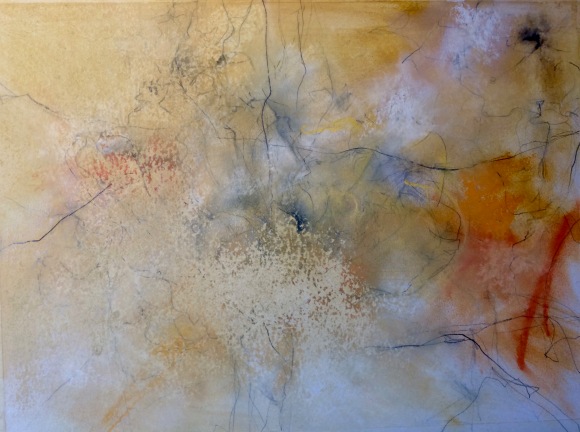
My second and third pieces begin to explore ‘lines’ of thought. I am trying here to understand what happens in the creative process of bringing ideas to the surface. I am exploring the directional thrust of an idea and how this breaks up and becomes something else – the clarity of the idea is lost or becomes less visible.


The final image is exploring the fragmentary nature of ideas. In this piece I tore up strips and pieces of tissue paper and let them simply drop onto surface covered in glue. I pressed these random shapes onto the paper wherever they fell. When the paper was dry I then sandered the surface down to create a smooth surface. Some of the tissue paper was lost in this step but it left behind random shapes of a lost image. I had briefly explored the shapes left after the original had been torn away in the sketchbook. I then worked with pencil and charcoal to create new lines of thought.



Sections of the image-
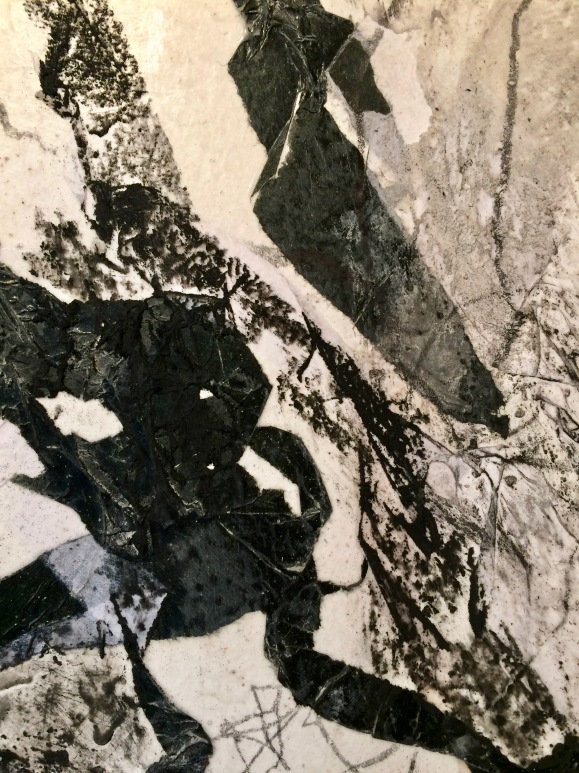

I could simply keep going with these continually emerging ideas but I think that this first step in this project of exploring the process of abstraction needs to finish for the moment. The most important element which has come out of these last pieces for me has been the importance of the preliminary exploration. I spent so much time exploring, questioning, that by the time I got to creating some final images, they just flowed onto the paper. All the confidence in my own mark making which had been building up during the preceding months, came together and there was absolutely no hesitation in the images which emerged.
Since the summer I’ve been keeping a sketchbook focused on exploring abstraction for the parallel project. This is different to the ‘Diary without words’ which is simply a daily record of emotions and experiences expressed abstractly. The aim of this sketchbook is to experiment with using other senses than seeing.
I began on one of the hottest days of the year. As you can see from the notes, I was exploring what ‘heat’ looked like, calling on memories of Australia, sounds, colours, textures…

I condensed these thoughts…

The visual happened in response to these ideas and feelings using mixed media , very spontaneous…

As I was involved in exploring this new way of seeing, I happened to catch a remark made by Trevor Cox, talking about acoustics on Radio 4 in the programme ‘The Life Scientific” (19-07-16), “The dominance of seeing has dulled all our other senses.”
This comment resonated with me as I struggled with closing off seeing with the eyes and just feeling the heat, experiencing the occasional cool breeze. Questions like what colour is heat, the colour of bleaching and losing the sharp outlines…
All of this work was very experimental…
I suppose when you begin to explore feelings and experiences you mustn’t be surprised at what comes to the surface of thought. I suddenly found that I was drawing memory…the link between days of extreme heat and Australia. What was happening on the page took a different turn and I began to work with exploring memory, place and time…
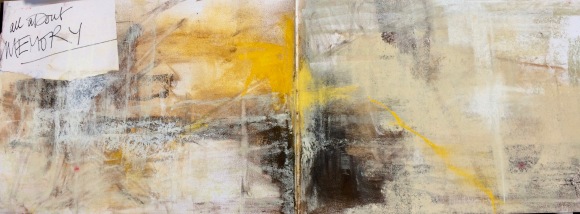


The fragments of memory began to take shape and how memory and experience take on a layered appearance…

At this time I was reading ‘Place’ by Tacita Dean and Jeremy Millar. On page 14, there is a quote from Thomas Hardy in The Woodlanders (1887)…”to belong in a place is to ‘know all about those invisible ones of the days gone by, whose feet had traversed the fields…The spot may have beauty, grandeur, salubrity, convenience; but if it lacks memories it will ultimately pall upon him who settles there without opportunity of intercourse with his kind.’ Place is thus a space in which the process of remembrance continues to activate the past…” This book activated so much thought about the past, memories and a sense of place and also the element of time…

This work began my experiments with line to see how much could be expressed through line…
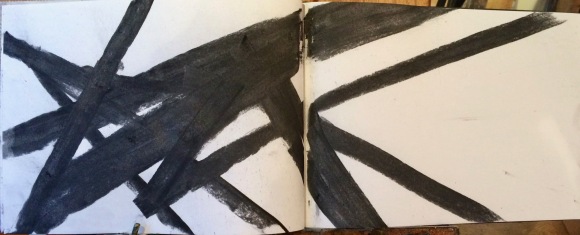
At this stage it was so interesting to see how ideas flowed from each other. There seemed to be a continuum – one idea flowing from another. As I was thinking about line and its expressive qualities, the news was full of comments and incidents of ‘post truth’ and I began working with line to express some of the ideas which were coming – confusion, secrecy, turmoil, tangle, without beginning or end, haze etc… What did a ‘post truth landscape’ look like?

The turmoil in the media stayed with me during this period and I began to abstract my response to the Trump inauguration. This was an interesting exercise…and I felt to extend my mark making here in the exploration of line. It was all line but using different media, different thickness, different emphasis, different tones…
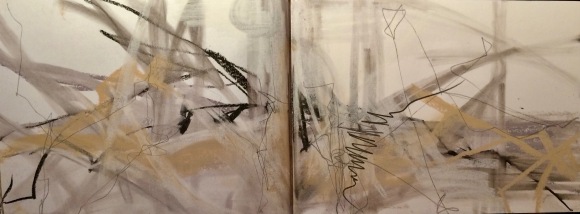
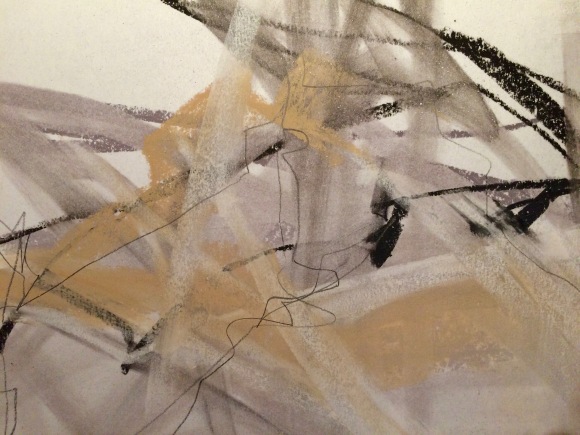

In this search for a new language and new ways of expression, I found that I was continually coming to an end of a road, continually exhausting the ‘mark’. This was one such time. I felt an urgency to find a new line so I went to another media…using dyed wool pieces, pastel and tissue, even added some acrylic ink…

The landscape seemed to be appearing (have learnt to go with ideas as they appear!) so continued to explore think and thin lines, strong radical lines next to thin wriggly lines…

The imagination took a leap here and that landscape suddenly became a figure…

I loved the contrast here of the lines!
The next piece of work originated in a diary entry for a day in which there was a complete absence of ideas but suddenly the red square appeared!


Another series of ideas came from this! What happens when an idea has gone? What does it leave behind? The red square had seemed so dominant. full of promise but the next day it disappeared and what was left? This led me into thinking about remains of thoughts and memories, fragments left behind…





The sketchbook so far…
This sketchbook has been an invaluable exercise for me and the work in it has become a resource of ideas. There are so many ideas here to follow up. I’ve learnt the need to respond to whatever comes to thought no matter how remote and also the exciting process of linking ideas and how they flow from each other. I think I’ve been able to capture the essence of ideas as they come and not worry about how anything looks. That development has come from abstracting ideas and thoughts – these are always with you! You don’t have to wait for the right landscape or flower or figure to appear. I’ve been dealing with thought…so exciting! The next step is to work with some of these ideas to create resolved pieces of work.
CRITICAL ESSAY
Critical essay
“REPRESENTATION OR ABSTRACTION: IS THAT THE POINT?”
“The eyes of one kind of painter look outward. The eyes of another look inward to the recollections that dwell in the recesses of the mind.” (Winifred Nicholson, 1987, page 239)
This comment by Winifred Nicholson in an article, ’Three Kinds of Artists”, first published by LYC Gallery in 1974, reflect a period in her artistic life when great change was happening, as artists, working in the first half of the 20th century, sought to reinvent the building blocks of artistic expression. There was an overturning of fundamental concepts and ideals in the movement from figurative to non-figurative art among her contemporaries and close associates, amongst whom was her husband at the time, Ben Nicholson, and Henry Moore, Ivon Hitchens, John Piper, Barbara Hepworth and David Jones. For most of the 1930s she lived in Paris where she became closely associated with Mondrian, Giacometti, Kandinsky, Gabo, Brancusi and Arp. This must have been an incredibly dynamic environment to experience. “These were years of inspiration – fizzing like a soda water bottle …Almost everyone one met as expressing genius, inventiveness, dedication to their vision…” is a description written by Nicholson for an exhibition of her abstract paintings at the Kalman Gallery in 1975. In ‘Three Kinds of Artists’ she talks about her personal journey to come to terms with the ‘primal forces’ that build art – ‘the primal force in geometry; in the circle, the rectangle, the triangle and their juxtaposition to one another… In colour: primal red, primal blue, primal yellow – no green, no neutrals…’ (Winifred Nicholson, 1987, page 239) This search led her to experiment freely, moving easily between representational and non-representational styles in the pursuit of her own dedicated vision.
I have begun this essay with a description of Nicholson’s experience because I feel to be at a similar point in my own practice. I constantly find myself drawn to abstraction and yet have no idea why and consequently have stayed in the safety of what can be seen with the eye. For me and for the purposes of this essay I see ‘abstraction’ as a process, a means of interpreting the world in order to find meaning. The Drawing 2 course with its concentration on in-depth investigation and experimentation into drawing has demanded new thinking. It has opened up alternate ways of ‘looking’ and consequently, a rethink about how to experience the world around me. As soon as ‘seeing’ becomes more akin to ‘awareness’, then a world of different responses become accessible. The senses of feeling, touching, remembering, responding, listening, exploring, expand vision and leave behind the limitation of the visual.
The question then arises, “how is this new way of ‘seeing’ to be expressed?” Can representational images reveal this new reality? Is abstracting what we experience the way to open up the world beyond what we see? Is it one or the other?
In my exploration into these questions, I decided to research two artists who on the surface appear opposite in their work and yet each have a profound effect on me as the viewer. I first encountered Diana Armfield at the 2016 Summer Exhibition at the Royal Academy, London. Among the huge array of paintings, I found that just one small canvas stood out. It was a simple image of nasturtiums in a vase. It was fascinating subsequently to read comments by Ken Howard in the forward to “The Art of Diana Armfield” by Julian Halsby, “…when we enter a mixed exhibition we immediately recognise the work of Diana Armfield. Here is a small, still voice that speaks to us quietly and persuasively. We have all witnessed each year how her work sings out at the Royal Academy of Arts Summer Exhibition, without the need of vast scale or strident colour…” (Julian Halsby,1995,page 7)
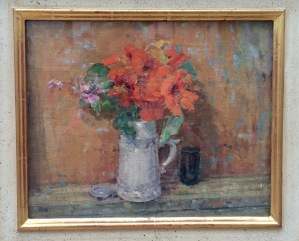
I love nasturtiums but this painting, entitled, ‘Nasturtiums with the Last Phlox’ was much more than a ‘flower painting’ and its impact went far beyond a favourite flower. There was a quiet dignity and grace in the image which gained dominance over the ‘noise’ of the exhibition. Layers and layers of feeling, love , recollections and continuity seemed to be evident in the simple image. The extension of the jug overhanging the shelf brought the image into the viewer’s space and it was as if we are pulled into the experience. The tension which was created by this eliminated the sense of finality or ending, emphasising to me, a feeling of continual renewal and energy.
It was with some surprise however that I read Armfield’s comment about her work in the article, ‘Diana Armfield RA’ , ( interview in Artists and Illustrators – page 24 – April 2017) “I think all my paintings are abstractions. The dull thing about abstract painting is that, to me, it has very limited meaning. It is akin to pattern making, just creating an ambience.”
This thought-provoking comment raised the issue of what ‘abstract’ art is? Going back to Nicholson’s comments at the beginning of this paper, it seemed to me that Armfield was an artist who both looked ‘outward’ at the same time as looking ‘inward to the recollections that dwell in the recesses of the mind.”
So what is abstraction?
The Tate defines the movement as, ” Abstract art is art that does not attempt to represent an accurate description of a visual reality but instead use shapes, colours, forms and gestural marks to achieve its effect. It may be based on a subject or may have no source in the external world.” (Tate website – art terms) Its development from the early twentieth century began first with the Expressionist movement in Russia involving “a free use of a Fauve-derived boldness of line and abstract use of colour as expressive entities in their own right “, (Camilla Gray, 2012, page 97) as can be seen in the work of artists such as Mikhail Larionov and Goncharova. Kandinsky (1866 – 1944) saw his abstract paintings as a pathway to spirituality. “He never lost the perception from early childhood that all objects and beings have an inner reality as well as an external form.” (Charlene Spretnak, 2014, page 82) But how to replace the ‘object in painting’? This was the challenge for those early pioneers into a new way of expression. Spretnak went on to describe how Kandinsky struggled with this question and “found eventually that he had always carried the answer within him: the new subject would be the inner reality of the world.” (Charlene Spretnak, 2014, page 82) Following these early years of the birth of abstraction came Cubism, Suprematism, Constructivism, Neo-Plasticism, Action Painting, Hard-edge painting and Op Art as artists continued to challenge preconceived ideas and theories in their search for meaning.
“…the new subject would be the inner reality of the world.” Taking this concept back to Diana Armfield’s, “Nasturtiums with the Last Phlox”, unlocked the ambiguity of her comment about her work and abstraction and the representational quality of the images. I understood what had been so startlingly apparent when I saw the painting – an image which went far beyond the mere representation of an object but indeed revealed an inner reality and involvement.
Just as I thought I was at last gaining a better understanding of ‘abstraction’, I came across this comment from Howard Hodgkin, one of the world’s leading abstract artists.
… “I am a representational painter, but not a painter of appearances. I paint representational paintings of emotional situations… ”‘ (‘Absent Friends’ exhibition, NPG, article in Art Quarterly spring edition, page 9)
As I read this, the terms ‘representational’ and ‘abstract’ began to take on new meaning. I went along to this exhibition at the National Portrait Gallery to try to absorb a deeper level of understanding and it was a thought-shifting experience. After the 1960s Hodgkin moved away from figurative description and began to explore pure colour, shape, mark and texture. This selection of paintings were obviously focused on portraiture and the fascinating question was, how can a painting of expressive marks and shapes ever have any subject at all, let alone the presence of an individual. There remains a strong conviction that a painting needs to replicate a material object or subject, particularly portraiture. Even Diana Armfield, in her comment above, indicates that without the representation of the object, the painting becomes a mere design with no substance. However, this selection of work from Hodgkin completely reversed this idea.

Although there was no physical appearance depicted, Hodgkin’s paintings were intensely rooted in the physical subject matter. The paintings talked of the relationship between people, memories and encounters with friends, his own feelings about himself and his work, all in abstract, as his world became a collection of impressions, experiences and memory. His reason for working in this way seemed so clear. The physical depiction of an individual’s appearance is as if that person is frozen in time and yet that is not how we experience people. Abstraction allowed him to truly explore his associations over years of memory. “Realised in this way, Hodgkin’s memories of people resonate and find expression in paint, each portrait connecting with its ephemeral subject…People come and go, their presence illuminates a moment, and their departing leaves a void. Memory, however, brings them back. By casting off a conventional allegiance to representing appearance…Hodgkin’s portraits redeem their human subject more profoundly.” (Paul Moorhouse, 2017, page 11)
Here was the answer I was searching for in my own work. I was looking for a deeper meaning beyond the visual appearance. In several of the last projects in Drawing 2, my work has gone through a process of exploration and experimentation as I have searched for the means to express this deeper world of experience. The first meaningful exploration of this came with assignment 4 in which I began a dialogue with a space created in the middle of a bamboo planting. I wanted to give expression to so much more than just the space itself.


This strong imperative continued in Part 5 in which I sought to find expression to the concept of ‘thought movement’ in contrast to physical movement and over a period of many weeks I experimented with abstract images. As this was an abstract concept it seemed obvious to use abstract images and yet much of the search centred around the impact of the inclusion of an object, namely the figure.
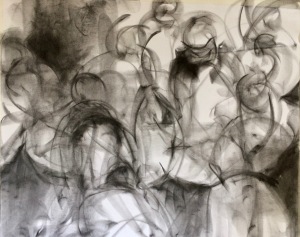


At the same time as these projects, I worked on creating a visual diary of my inner world, in which I explored mark making techniques, shapes, colour and texture to express my feelings each day. I began with abstract images but found at one point that I needed to include presentational images and experimented with this. This ‘diary without words’ has been hugely instructive in this question of abstraction because it required a new language from me in my search for my own distinctive visual language.
After much research and personal experimentation, my conclusion to the question, ‘Representation or Abstraction: is that the point?” has to be in the negative. Caspar David Friedrich, (1774 – 1840) a German romantic painter, wrote, “A painter should paint not only what he sees in front of him but what he sees within. If he sees nothing within himself, he should desist painting what he sees in front of him.” (Sigrid Hinz, 1968, page 128) In the work of each of the artists in this paper, whether figurative or non-figurative, I see individuals who are ever searching for new meaning so that what they paint is not as important as the process they go through in order to express their vision of the world. I have experienced this in my own work for the course and know that what happens on the canvas must come from a process of listening, experimenting, questioning, seeing beyond the obvious – a continual process of abstracting. Tara Geer expresses this process in these words, “The drawing takes over, pulls, with wide hands, me in, like a commanding dance partner, and I cannot claim to really be in control of them. I just follow. I don’t seem to be drawing the outside world then, but nor do I feel like I’m making it up– it’s as if I’m drawing something just beyond the surface of the page. I’m drawing something I feel there, insistent, impatient, almost bullying.” (Tara Geer website)
BIBLIOGRAPHY
Edited by Nicholson, Andrew, 1987, Unknown Colour – Paintings, Letters, Writings by Winifred Nicholson, Faber and Faber Ltd
Julian Halsby,1995, The Art of Diana Armfield, David & Charles
‘Artists and Illustrators’ Magazine– April 2017
Camilla Gray, 2012, The Russian Experiment in Art 1863 – 1922,Thames & Hudson
Charlene Spretnak, 2014, The Spiritual Dynamic in Modern Art – Art History Reconsidered, 1800 to the present, Palgrave Macmillan
Paul Moorhouse, 2017, Howard Hodgkin – Absent Friends, National Portrait Gallery
Sigrid Hinz, 1968, Caspar David Friedrich in Briefen und Bekenntnissen, Berlin: Henschelverlag Kunst und Gesellschaft,
Background research
- ‘Spirituality in Contemporary Art-the idea of the numinous’
Jungu Yoon
- ‘The Russian Experiment in Art 1863 – 1922’
Camilla Gray
- ‘Place’
Tacita Dean and Jeremy Millar
- ‘The Spiritual Dynamic in Modern Art: Art History Reconsidered, 1800 to the present”
Charlene Spretnak
- “Point and Line to Plane”
Wassily Kandinsky
- “Concerning the Spiritual in Art”
Wassily Kandinsky
- “New York Studio Conversations”
Edited by Stephanie Buhmann
Also
- Article from The Burlington Magazine July 2015 – “Immortal mind: Christian Science and Ben Nicholson’s work of the 1930s” by Lucy Kent
- Also article “An act of praise: religion and the work of Barbara Hepworth” by Lucy Kent
“Victor Pasmore: Towards a New Reality” – exhibition catalogue. Djanogly Gallery, Lakeside Arts, Nottingham
.
REFLECTIONS : TUTOR REPORT – PART 5
In the post for April 3rd, ‘REFLECTION: Assignment 5 and the course as a whole’, I wrote about my sense of achievement in the point that I feel to have reached at the conclusion of Drawing 2. This is not to be confused with any feelings of complacency! I know the personal struggle there has been to grapple with new ways of working and the level of thinking and determination which has been needed. I also know that this is only one more ‘rung of the ladder’ and that there are many, many more…endless, I’d imagine!
This tutor report for Part 5 feels to me to be an endorsement of the comments I made in that post. Perhaps the most important element of the report for me is the fact that quality time has been given by the tutor to examining the work and making the connections. In the distance learning setup, communication assumes a greater importance perhaps than in face to face tuition. So a lot relies on the student spending time carefully documenting every step of the creative process but also the tutor taking the time to make the links. I appreciate that this probably isn’t always easy but it is essential. However, just as important as all the words, is the ability of the images to reflect the thinking process – to say what the student wants it to say or thinks it says! This element seems to have been a continual struggle for me throughout the course and it has been continually said that the final work does not reflect the thinking process. So I’m very pleased to find that in this last section of the course that all of the parts have come together and that there is clarity and connections which are easily seen and acknowledged. The resolution of an idea can be a long time in coming and I wonder if in the past I have stopped before the completion of the idea. But not in this case!
I’m also pleased with the acknowledgement of the experimentation which I’ve shown in the work. Searching for a new language in the exploration of ‘abstraction’ has been the driving force behind that experimentation. In this search, you are not only learning a new language but you are also having to create that language for yourself. I understand that one’s personal language is ever evolving. It was interesting to observe in my recent visit to ‘Absent Friends’ at the NPG, that renowned abstract artists like Howard Hodgkin develop their own personal vocabulary of marks and one sees these marks repeated over and over in the images. Finding fresh marks has needed pushing through boundaries. Just as in writing one finds oneself using the same vocabulary, so I’ve found myself growing bored with my own marks and I’ve used many different mechanisms to break through this. It’s a fascinating quest.
I’m grateful that all the work I’ve done with ‘line’ as a new vocabulary has been noticed. This has been a major part of my work for this section.
The report highlights the difference between abstract artists and artists who abstract and this insight has given me such a fresh and exciting perspective on my work. I realise that much of my research has been on the formal elements of abstraction as recommended by my previous tutor. This report has shown me that my work shows a fluidity in contrast with ‘pure abstraction’ and I’m grateful to have had this pointed out. I hadn’t seen this myself. I am looking forward to exploring this idea in greater depth as I think it will give me a greater understanding of my own work. Even though the research has been along formal lines, I’m grateful to have been encouraged to do this work as it has given me the background I needed into the development of abstraction as a movement.
I guess perhaps the most important aspect of this report for me is the encouragement it has given me to continue to develop my voice. It has honestly acknowledged where I’ve got to, it has understood where I’m trying to get to and has given me the encouragement to keep going. Thank you for this….
TUTOR’S REPORT – PART 5
TUTOR’S REPORT – PART 5
Overall Comments
Patricia, thank you for an informative submission, which displays your methodology and journey of drawing in a developed way. This is a dynamic, bold and substantial submission which shows a sense of self-discovery and a boundless sense of exploration in your personal language of drawing. The shorter project works have allowed you to be fluid by fusing abstract ways of seeing with the concrete ways of looking. I like how you have abandoned yourself by reflecting and digesting the world around you without seeing an answer at the time. Very tricky to do sometimes. You have strength in leaving work alone and letting it be. You are getting there with your parallel project (PP) and you have moved away from the obvious of the typical notions of abstraction, having a subject of only flowers and the language of line. It is fine for your PP to reflect your practice as long as there is a line of enquiry, which is clearly developing, everyday.
Feedback on assignment
Demonstration of technical and Visual Skills, Quality of Outcome, Demonstration of Creativity
Project 1- you dissect, reflect and digest the scene of the V&A in an interesting way where you study what time can mean conceptually. And because of this, the works are fluid; show movement but also a static notion of the standstill of time. Using ghostly marks and traces gives a sense of what has been but the dark palette depicts a continuous solid presence of an audience. What really works with the studies in your sketchbook is the layering of delicate and harsh media to build a tension of atmosphere- is it a dark place or is it crowded?
The consistency of the fluid figure is carried into the motionless figure and I think that this has given you some freedom to be really loose in your application but also build up and see abstraction in your work for your parallel project. And how useful that your thinking methodology is an abstraction of thinking as well the physical work itself.
Artists Book- this is an insightful and self-actualising way for you to develop previous concepts especially with space and your grand-daughters’ relationship with bamboo. As you say it’s not the bamboo that’s changed but her opinion of it. These drawings add to the commonality of your practice with dramatic marks, atmosphere and ghostly suggestion of what once was. Your ability to layer creates depth to the drawings but there could be more play with the artists book itself. This is a small project but be more dynamic with the way the existing formats of the book as you have done with an alternative drawing tool.
Project 3- I like the fact that you see a ‘finer focus’ as deeper listening so go back to some of your darker layered works and could you incorporate this finer focus in them more? This layering and intricacies could enhance some of the areas in your work so there is more intrigue. However, you work much better when you work with a darker palette than a colourful one, although still subdued it does not quite communicate the fluidity and movement of your work.
Project 4- this is an engaging piece of work which holds sophistication in the way you handle the chosen drawing media. There is an investigation into the charcoal, pastel, eraser, chalk and each have been used in relation with the other. This is either to create tension between the qualities of line or intertwining the threads of marks together. Without seeing the lines of time as sporadic and separate pieces, the unity is told in the tonal qualities used. It reminds me of cartography or GPS lines (art work has been done using GPS lines which you could look into.) I did spend time looking at the layered elements of this piece.
Assignment- you have continued to explore the meaningful way in which you work which is tapping into the thought of thinking as a visual language. This is a very interesting concept, which echoes throughout your practice.
There has been perseverance in your conclusion to the assignment. You have battled with the obvious and I am glad you did not go for work that is accessible and moved away from the figures and portraits. You have documented your journey well and this comes through the most in ‘Thought Lines’ (yellow and blue) because it describes your notions of your entire subject through not only lines but also colours and textures. The lilies seem too held back for you and although the other ‘Thought Lines’ piece (pink and blue) is a natural development for you, it seems a little repetitive to project 4. The Blue and Yellow piece, adds a different dimension to your work where a further exploration of atmosphere is created. The linear qualities show the exploration of a space with semi-geometrical and fluid lines incorporated.
Parallel project– this is an interesting way to start “Is the subject of your drawing important enough?” And I am glad you have played with the idea of exploration through drawing rather than giving answers. However, the subject of flowers is too concrete and limiting, as it is a subject that has been done many times. You then go onto think about the sense of spirituality and this is a useful move as you have identified it will not involve just flowers. However, be careful not to be too twee with this subject matter as it can become quite mystical. Your current practice involves, atmospheric, ghostly, traces and almost an elemental quality and this is engaging.
‘A Diary Without Words’- although you have done a substantial amount of research so far related to abstraction in your own work. Are the artists relevant? The movements that you list can be quite formal and ordered and compare this to the fluidity of your own work. A lead is perhaps looking at the untouched elements of your visual collection. This will disallow you to overwork and make yourself to make things look good. These images are dynamic and explosive but they are confined in frames and edges of a book. Does this reflect the formal qualities of abstraction? Something for you to think about.
Your search for a new language is interesting because you explore line as a vocabulary. Line is not only explored ion your mark making but the way you move the camera lens in a straight line, the lines of the edges of the concertina book and pages and even the lines of the grains on your table. Maybe your work can incorporate lines, which we dismiss subconsciously?
Sketchbooks
Demonstration of technical and Visual Skills, Demonstration of Creativity
Your sketchbook is explosive and full of investigations with a common theme of investigating lines, marks and abstraction in your works. These studies have helped you plan and test for more refined work in larger pieces. There are good connections between your primary sources and inspirations, which show a clear response in the practical work you, do.
Research
Context, reflective thinking, critical thinking, analysis
You have an array of artists, which have fed, into your work moving forward. You are inquisitive with the questions their work surround. Good comparisons and fine not to like everything as this builds up you critical thinking and having a stance by reading lots of different sources. Looking at the contextualisation of the exhibitions you have seen has enlivened your appreciation of art and by looking at wider issues, I hope this has helped you think about what the audience might see in your work. There is certainly a personal voice coming through in your research and with connections to your own work.
Learning Logs or Blogs/Critical essays
Context, reflective thinking, critical thinking, analysis
You reflect very well on each project and go beyond the obvious so you are thinking deeper about how you work, think and make as an artist. Your logbook is substantial and it has been insightful to read behind your thinking which has an air of self-discovery and realisation.
Your critical essay on Auerbach reads well with an object but subjective journey of the exhibition. You dissect and connect concepts with his techniques but at the same time continue to be your inquisitive self. This is a good stance for your critical essay.
Suggested reading/viewing
Context
- Marlene Dumas- fluidity of the media, atmosphere, semi-figurative
- Leon Kossoff- Movement and introduction of colour in your works.
- William Kentrdige- videos – this artists works with animating his charcoal drawings. There are many YouTube videos.
- Not sure of you’ve come across this book but tere are great articles in there about the language of draing whch will aid you with your PP.
Jack Southern, The Drawing Projects: An Exploration of the Language of Drawing Black Dog Publishing; 1 edition (August 2, 2011)
Pointers for the next assignment
- Reflect on this feedback in your learning log.
Please inform me of how you would like your feedback for the next assignment. Written or video/audio
Critical essay (plan)-
- Be careful with the word abstraction- are you seeing as a process, a technique or an art movement? Define this right at the beginning.
- To focus on two conflicting statements will give a line of enquiry and a claim to the essay once you define what you mean by abstraction. Make sure the arguments and your analysis of them fits in with your definition.
- Good to focus on two of your works rather than everything.
- Be careful not to assume the conclusion- it can be seen as flippant to say that work can be seen as objective so make this thinking more concrete.
Well done, I look forward to your final assignment.
| Tutor name | Diana Ali |
| Date | 22/04/17 |
| Next assignment due | 14/05/17 |
PARALLEL PROJECT : Diary without words cont… March
This is the final post concerning the Diary. It has been the most interesting exercise for me and I feel has taught me more about abstraction than much of the research. March entries for the Diary are not complete because of the creative energy and focus that was going into my other work. I was working on my final assignment pieces which, as you can read in my posts, was all about depicting ‘thought’. This proved to be very intense creative and mental work and I noticed that the diary entries consequently stopped. As I thought about this, I realized another aspect of abstraction which is the almost obsessive nature of it. The work that I was doing for the assignment required total focus in order to sift through layers of thought. Sometimes most of the day was spent in just thinking and waiting for the right mark. Exhausting work! There was just nothing left for the Diary. I didn’t mind about that as it taught me more about the journey I was on. However, the daily entries into a visual diary are so valuable that I want to start it up again for my own development.
Critical Essay
Initial outline for critical essay
Critical essay…
What is a critical essay
“..it should focus on how you can gain further understanding of your own work through an understanding of an established artist or art movement.”
——————————————————————————————–
TITLE: “Representation or abstraction: is that the point?”
-gaining a better understanding of my own work through an understanding of an established art movement – ie ABSTRACTION
- Introduction
Development towards abstraction in my own work
Drawing 2 course has encouraged deeper views of drawing, in particular investigating further into different ways of ‘seeing’ and ‘responding’.
- Two seemingly conflicting statements
Research – Diana Armfield and Harold Hodgkin
Diana Armfield RA (from interview in Artists and Illustrators – page 24 – April 2017)
-“I think all my paintings are abstractions. The dull thing about abstract painting is that, to me, it has very limited meaning. It is akin to pattern making, just creating an ambience.”
Howard Hodgkin
‘Absent Friends’ exhibition – NPG – article in Art Quarterly page 9 Spring
“As he once said, “I am a representational painter, but not a painter of appearances. I paint representational paintings of emotional situations.” His career has been dedicated to the impossible task of pinning down what’s beyond words: recalling fleeting everyday encounters and somehow fixing them in physical materials”.
- So what is ‘abstraction’?
– Tate definition
-Reading
Roger Hilton 1950 abstraction
‘Painting is feeling. There are situations, states of mind, moods etc which call for some artistic expression; because one knows that only some form of art is capable of going beyond them to give an intuitive contact with a superior set of truths.’
Tate website ‘Composition in Orange, Black and Grey.’
- My own exploration
Diary without words
Personal work in Parallel project
- Conclusion
-Whether abstraction or representation, it’s all the artist’s objective way of responding to what he sees
-‘search for truth’
‘The right date may not be 1915, and it’s wrong to equate this movement only with Malevich and equally “revolutionary” art. For abstraction has other roots. Supporters of Pollock in the 1950s found antecedents not in the ideological modernism of a Malevich, but the mystical poetry of late Monet. If you want to plunge into abstract art, to be lost in colour, sensation and obscure memories, you can’t do better than Monet’s waterlily decorations. Or go and look at some Cézanne. The shapes of things shatter and break under his restless gaze. Great patches of abstract colour infuse nature.”
“No, abstract art was not invented by the Russian revolution. It started to invade painting as soon as artists began to realise that as hard as they tried to paint nature, the colours they set down were the stuff of their own mind’s eye. The discovery that truth is subjective is the root of abstract art. It is also a fundamental insight of modern physics. Perhaps that is why, in front of Pollock, I feel I am seeing the shape of the universe itself.”
Guardian article – Jonathan Jones 19 December 2014 – “Abstract Art Unlocks the Truth about the Universe”
PARALLEL PROJECT
From images of the mind to seeing
Post 6
Now that the final assignment work is finished I’m starting to gather up the threads of the parallel project. As I’ve said in my other course work posts, the parallel project topic of Abstraction has been a dominant thread throughout Part 5. In project 1 – A Changing Scene – the sense of movement and its link with time stimulated abstract images and gave rise to questions about the movement of thought and its contrast with the stationary figure. Two pieces of work came out of this as well as the development of new concepts and images for the final assignment images – all abstract!


Project 2, on the making of a book, allowed me to pick up on ideas from Project 3 in Part 4. This project had focused on space and the dialogue with a space which a drawing can have. This project had become very personal for me and was my first experience of the intimacy of a space and its relationship to the passing of time. I was able to explore these ideas more deeply in the book format and again, became a further exploration of abstraction.


Project 3 – A finer focus – again allowed me to explore the incredible landscape which exists in small areas on the skin of a fruit. This has opened up ideas about the minute details of the visual world which exist to be explored…once again, abstraction.
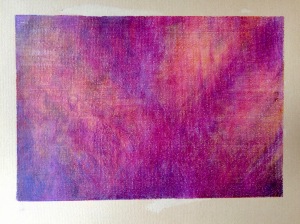
Project 4 – Time and the Viewer – also gave me the opportunity to delve further into an abstract image from my daily diary and create a piece which would be interesting enough for the viewer to want to spend time with.


Then the final assignment work embraced the whole module and became a record of the changing lines of thought which occur over a period of time.
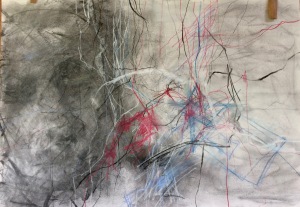

So, in a way, this whole section of work from Part 5 has been about my parallel project. I’m finding that abstraction is becoming the way I think and see the world. Up to this point I’ve concentrated mainly on emotional responses through the work in the daily diary. This has been invaluable in stimulating new marks and raising my confidence in my own personal voice.
I want now to move on from emotional responses to explore links with abstraction and the visual world. Tara Geer wrote, in ‘Thinking through Drawing: Practice into Knowledge – an exhibition accompanying an interdisciplinary symposium on drawing, cognition and education – 2011- “The world is strange and beautiful and full of awe. For me, drawing is about piercing apart all the named, known objects around me; teasing them into a pure meaningless visual field. Not window, table, wall, hand, but fat oily lines, shivering, hairline cracks, darkness…” (Page 50 – ‘What we illustrate when we draw: Normative visual processing in beginner drawings, and the capacity to observe detail’ )



